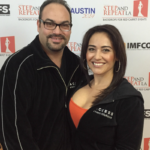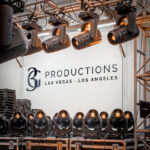It was the year that Big William Howard Taft was president and little Marie Curie published her Treatise on Radiography; Mark Twain died and Django Reinhardt was born; Jack Johnson ruled the ring and the Titanic was being built.
Oh, and Rosco Laboratories was born.
A century-old company still surviving in this industry is unusual enough, but when you consider it's had just one change in management, that's quite another. This is the story of Rosco – at least so far.
Starting 100 years ago, Rosco has grown to be practically ubiquitous. Few if any of us reading this haven't used their products. Its reach is vast. Today Rosco is a multinational company employing over 250 people in 11 offices on five continents.
"Rosco was founded on the color filter, and that is still the core of our business," says executive vice president Stan Schwartz, who has been with Rosco for 25 years. "But we've expanded beyond that. Gobos are important. We've also become the leading supplier of scenic paint."
There is also the Litepad and their fog products too. Rosco's desire to meet their customer's needs have led them down many unforeseeable paths, from their vinyl and wooden sub-floor products for dance studios to their digital imaging division. Their innovations have led not only to commercial success, but also to many awards, including the one named Oscar. Or four.
Coloring Broadway

Rosco Chairman Stan Miller recently inked the company's history, and he writes that there's not much known about the earliest days. "The company was founded in 1910 in New York by Sydney Kelsey Rosenstein when he was 24," he scribes. "Rosenstein was a chemist and his first products were Colorine, a transparent dipping lacquer for coloring small light bulbs, and Opaline, a translucent lacquer."
Rosenstein's naming of the company was not particularly inspired. He took the beginning of his last name and slapped "co" as in "company" behind it. His first big break came because of World War I. Theatres were importing gels from Germany, and when that supply dried up during that Hun-shunning period, Rosenstein met the demand. "It wasn't that easy, but Rosenstein convinced a chemist friend, Mac Weiner, to leave Rockefeller University and take on the challenge, and suddenly Rosco was in the gel business."
For the company's first 48 years, Rosenstein saw to it that Rosco lived up to slogan, "We color the night lights of Broadway."

In the 1950s, Miller was a salesman for Allied Chemical and Dye, and Rosco was one of his clients. As Rosenstein entered his 70s, he spoke of selling the company. Miller turned to his cousin, Len Kraft, who was an accountant. In August of 1958, they bought Rosco. (Kraft passed away from cancer 20 years later at the age of 46.) "I was a young salesman, but I knew the company. [Rosenstein] had no desire to grow the company. I was optimistic that we could do more with it."
The "Really Big Shoe"
The company has had many significant milestones. They introduced Roscolene in 1955, and it is still offered today. Initially, it was a surface-coated filter, but eventually it became an extruded-body colored filter. Rosco created more colors, and by 1959, the numbering system was unworkable, Miller says. "We went to 201-283 for gel and 801-883 for Roscolene." The Roscolene range evolved over the years. In 1960, lighting designer Abe Feder asked Miller to bring color samples as he developed his plot for the new musical, Camelot. "With lights on a pipe and [scenic designer] Oliver Smith's sketches, Feder tried different color combinations. That night 841 and 843 were created for the lavender-rich musical."
In 1968, The Ed Sullivan Show was scheduled to start broadcasting in color. They bought 1000W cyc strips from Kliegl and put stripped glass color frames on them. "It was like popcorn popping as the glass broke." They turned to Rosco, and found their gels would hold up. "Unlike the plastic filters, it wouldn't melt when heated," Miller explains. "We went in and showed them how to puff the gel out in the frames and gelatin became the standard color medium at the networks well into the 1980s."
Even the top filmmakers turned to Rosco. In 1971, cinematographer Gordon Willis was shooting The Godfather and "he wanted a certain sepia tone for the opening party shots, but he couldn't find the right camera filter. We offered to make a run of 282, Chocolate, with the tint change he was seeking." Rosco would earn its first of four technical Academy Awards for this camera filter work in 1974.

(Pop culture trivia note: some readers will recall the streaker who ran across the stage as David Niven was speaking at the Academy Awards. Among those who got an eyeful was Miller, who was just offstage waiting to receive his award.)
Into the Fog
In the summer of 1978, Rosco exhibited at a trade show in Hamburg, Germany. There they met a special effects specialist from the film industry. "He was demonstrating a fog fluid he had developed which made smoke without using oil," Miller writes. So they licensed it to sell stateside.
"If you were shooting a commercial that used it, you'd often work all day with that mineral oil getting into your system." In a very delicate manner, Miller hinted that, among other problems, the oil acted as a…ahem…laxative. "Let's just say the next day everyone would blame the caterers." While a German special effects firm developed it, they brought it to North America and promoted it worldwide. Rosco accepted another Academy Award in 1984 for this. And as they delved deeper into this market, they wound up making fog machines as well.
Gobos, Scenic Paint
Custom-manufactured gobos were commonly requested by designers in the U.K., "but such requests were rare in the U.S. through the 1980s," he said. Eventually, the demand reached a point where Rosco set up its own gobo and dichroic manufacturing facility in Austin, Texas.
By 1980, the company had gained a foothold in the scenic paint market, and when Iddings, a 50-year-old paint company became available, Rosco bought it. "As has been the case with every other Rosco product, Rosco dealers who had never sold anything without a cable found they had customers for this paint and put in a stock."
"The Next Step"
Today Miller is "technically the chairman," which he describes as relying on president and CEO Mark Engel while "I just do things I choose to do and leave everything else to Mark."
Miller, now in his 70s, says he never envisioned that Rosco would become what it is today. "I think entrepreneurs envision some growth, and you see the next step." For he and Kraft, the first step was getting beyond the $72,000 a year the company was bringing in when they got it. "It barely supported the two of us, and then we thought, boy, if we could get to $100,000…" Then when they hit that mark, they start dreaming of doubling it
"I certainly remember when we broke a million," he laughs. "But while you're dreaming of chauffeurs and upstate estates, what really happens is that the expenses go up." Then, as today, the money was constantly reinvested – to the point where Miller muses if maybe old man Rosenstein was actually making more money than he is today. Laughing again, he blurts out: "I wonder if I've really done better!"
Miller's success is built on the simple art of listening. Even as late as the mid-1960s, no one was talking to Hollywood's camera operators and electricians. "I began to call on them on film sets, because we were making products for them but I didn't know much about how they were being used," he recalls. They would say how they wished for something but had been told many others couldn't do it. Miller would step up and say, "I can do that!"
Miller and company's work has earned them an enviable reputation. "We pay attention, and can take people's ideas and commercialize in ways people appreciate. Our custom gobos for example – we pay the designer a royalty, and publish a catalog with their names on them and give them full credit."
Everyone at the company is proud of their dealer network. "When we took over from Rosenstein, he sold direct to users and dealers," Miller says. "I wasn't as sharp! It was just too complicated, as you'd get an order in the mail and have to try to remember if this was a place you sold direct or through a dealer. I decided it made more sense to go through dealers, and to this day we've kept that policy. It's worked well for us."
People Power
Then there are his people. "People tend to stay, and I'd like to believe it's because we're doing it right. I want people to stay. It's good business, and things functions better." He's sincere enough to admit he's even done some things that make him uncomfortable, like let some employees work from home. "It's hard to feel people are working when they aren't around, but I had to change to accommodate the modern employee. I've learned it's possible."
"His vision and energy has propelled Rosco," Schwartz says of Miller. "It was his vision of making the company into a multinational one." Schwartz speaks admiringly of his energy, and tells a tale of back in the day when Miller was "never content to make just two blue filters," and when knowing designers would prefer, say, six, he kept increasing the palette choices to, say, 34 different blues.
While director of U.S. sales Ed Donohue has been in the business for 30 years, he's only been at Rosco for two. "He has two innate gifts," Donohue says of Miller. "One, he is smart. He'd deflect [that comment], but his thoughts are always lucid, thoughtful.
"His second great gift is his ability to spot talent. This is the brightest group of people I've ever worked with." Donohue adds that Miller is almost "egoless" in addition to being empathic and a good listener, which always makes for a good working environment.
"Who better to work for than Stan Miller?" asks Rosco product manager Anne Hunter rhetorically. "He's not just an industry icon, but a natural leader – and for me, a teacher."
Engel adds: "I want to say he's a visionary. Stan really has a unique way of looking forward and seeing through the clutter." Engel agrees that the company's greatest strength is its relationships, in large part because relationships are so important to Miller. "We have tremendous relationships with our customers, dealers, vendors, and our own people. Stan's sense is that people matter."
The Next Century
When asked about the next hundred years, Engel first jokes that he's hoping he's still around. Then he adds: "We'll continue to reinvest in the company. Obviously, there will always be changes, but we'll be in colored lighting for the next 100 years. The form will change, but the language will remain the same. I'm convinced that Rosco #26, for example, will still be a reference.
"We'll continue to branch out into related products, and our core emphasis will still be our dealer distribution network and our branding. We see our fundamental challenge to continue to create innovative solutions for creative people and their creative vision."


